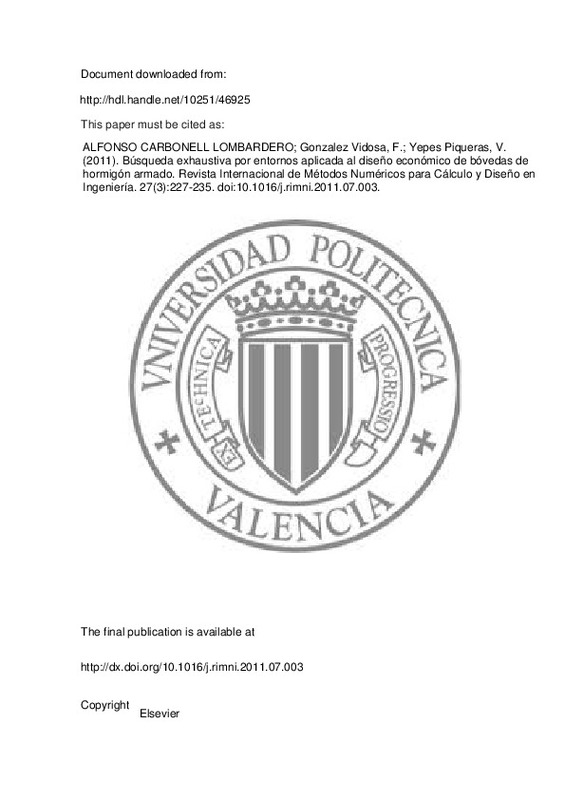|
Resumen:
|
[EN] This paper presents two gradient algorithms applied to the economic optimization of reinforced concrete vaults, typically used in the construction of underpasses. The algorithms are gradient multi start neighbourhood ...[+]
[EN] This paper presents two gradient algorithms applied to the economic optimization of reinforced concrete vaults, typically used in the construction of underpasses. The algorithms are gradient multi start neighbourhood exhaustive search procedures. The vault is defined by 45 design variables and the objective function is an economic one. Both methods have been applied to a vault of 12.40 m of diameter and 3.00 m of lateral walls. Design variables have been coded in base 2 for algorithms GB1 and in Gray coding for GB2. The neighbourhood is defined by the set of solutions that differ in one bit. The Gray coding solves the lack of proximity between two solutions typical of the ordinary binary coding. The positive effect of the Gray coding is proven in the present paper, where the average cost of 3,000 runs of GB2 improves by 3.81% a similar run by algorithm GB1. In addition, GB2 attains the best cost solution. The paper includes a stop criterion for the algorithm based on the stability of the statistics of the multi start results. The algorithms are simple and can be applied to other structural problems. The structure of best cost has a high slenderness and a span to depth ratio of 40. The study reports savings of 6% when compared to a design by an experienced practitioner office.
© 2010 CIMNE (UPC). Published by Elsevier España, S.L. All rights reserved.
[-]
[ES] El artículo presenta dos algoritmos multiarranque de búsqueda exhaustiva por entornos de máximo gradiente aplicados a la optimización económica de una bóveda de hormigón armado empleada en la construcción de pasos ...[+]
[ES] El artículo presenta dos algoritmos multiarranque de búsqueda exhaustiva por entornos de máximo gradiente aplicados a la optimización económica de una bóveda de hormigón armado empleada en la construcción de pasos inferiores. La bóveda se define mediante 45 variables discretas, siendo la función objetivo el coste. Los métodos se han aplicado a una bóveda de 12,40 m de diámetro interior y 3,00 m de altura de hastiales, con un relleno de tierras de 1,00 m sobre clave. Las variables se han codificado en base 2 para el algoritmo GB1 y en codificación Gray para el algoritmo GB2. El entorno queda definido por el conjunto de soluciones que difieren de la solución actual en un solo dígito. La codificación Gray soluciona la falta de adyacencia entre soluciones próximas que conlleva la codificación binaria ordinaria.
Su efecto positivo se comprueba en el artículo, donde el coste medio de 3.000 ejecuciones de GB2 es un 3,81% menor a 3.000 ejecuciones de GB1; además, ha permitido alcanzar la solución de coste mínimo.
El artículo plantea un criterio de parada de un algoritmo multiarranque basado en la estabilidad de los
estadísticos de la muestra de óptimos locales obtenidos hasta el momento. El algoritmo presentado es
sencillo y generalizable a cualquier estructura. La estructura de coste mínimo presenta una esbeltez
importante en la bóveda, con una relación canto/luz inferior a 1/40. Se han encontrado ahorros cercanos al 6% respecto a una bóveda real disenada siguiendo los procedimientos habituales de cálculo de una oficina de proyectos experimentada.
© 2010 CIMNE (UPC). Publicado por Elsevier España, S.L. Todos los derechos reservados.
[-]
|







![[Cerrado]](/themes/UPV/images/candado.png)


